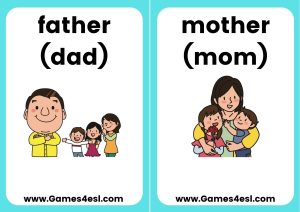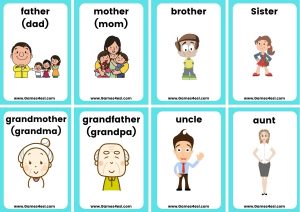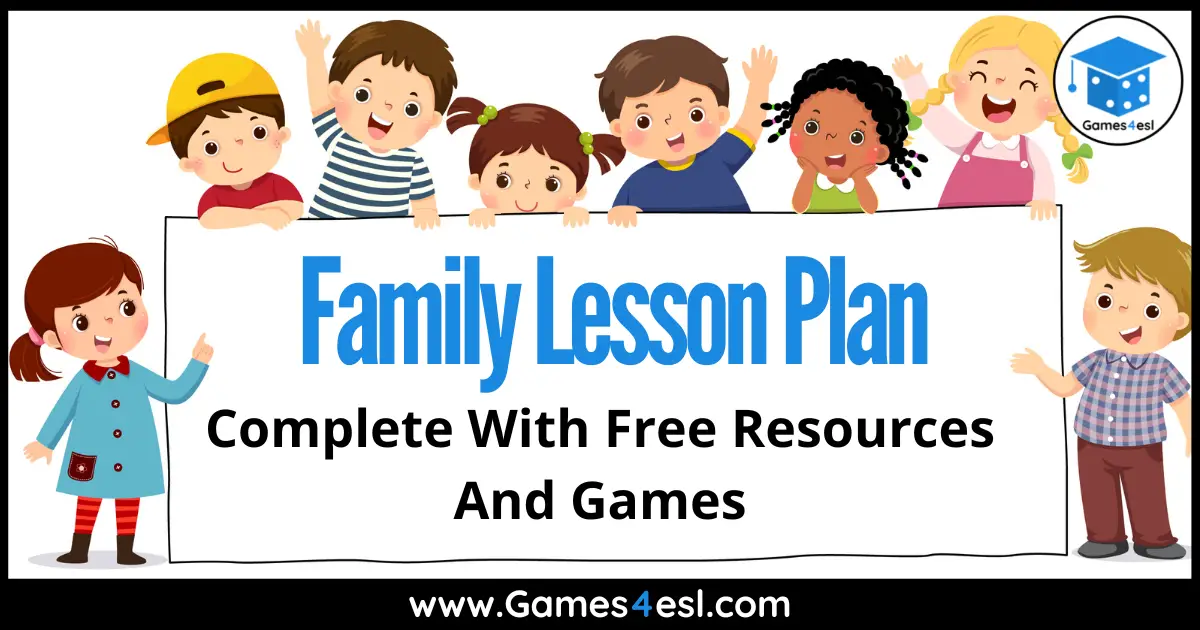Family Lesson Plan
This family lesson plan is great for teaching kids and beginner English language learners about the members of the family in English. Learning vocabulary and expressions about family and family members is essential for ESL learners, both young and old. Everyone has relatives, so this topic is something everyone can relate to. Learning to talk about families connects students’ real-life experiences with what they learn in the classroom, which is great for language learning.
On this page, you can find a complete ESL lesson plan about family and family members. This lesson plan includes all the materials you need including PDF flashcards, student cards, and board games. The games and activities on this page will have your students talking about their families in no time.
This lesson plan is mainly aimed at kids/beginner learners of English. See the below to download all the materials needed for this lesson. In addition, at the bottom of this page, you can find additional materials to teach about family members to ESL learners.
Materials for this lesson:
Family Lesson Plan
Introduce the Topic, Keywords, and Expression

Before teaching the keywords for the lesson, it is important to put the lesson into context so that students understand what they will learn. This will also activate the students existing knowledge about family vocabulary.
The easiest way to contextualize a lesson about family is to show students pictures of your family. Showing your family will likely be very interesting to your students, especially if you teach young learners. Show students pictures of your family and ask them to guess who they are. For example, show them a picture of your brother/sister and ask them to guess how they are related to you.
This can lead to some funny answers, especially with kids, who don’t always have a great concept of age. In many of my classes over the years, kids usually guess that my older brother is my dad, and my dad is my grandfather.
Next, practice the keywords for the lesson using these family member flashcards. Show students the flashcards one by one and ask them to repeat after you. Then, show students again and ask them to say the words on their own.
Once students have practiced several times, it’s time to introduce the key expressions you will use during the lesson. The key expressions you use will depend on the age and level of your students and your particular curriculum. Here are a few example sentences you can use while teaching a lesson on family:
- Who’s this/that? – This is my (father).
- Who’s he/she – He/She is my (brother/sister).
- What does your father/mother do? – He/She is a (pilot).
- How many brothers and sisters do you have? – I have 2 brothers and 1 sister.
Activity 1: Nice To Meet You Game
After introducing the keywords and expressions, it’s time for a fun game to practice some more. This activity involves the whole class and requires a set of family flashcards.
How To Play:
Place the family flashcards on the board in a horizontal line. Then divide the class into two teams. Next, the two teams should line up at opposite ends of the line of flashcards. One student from each team should move down the line towards each other, touching each flashcard and saying the key sentence as they go. For example, ‘This is my father.’, ‘This is my mother.’, and so on. When they meet, they should stop and have a dialogue using the key expressions. For example,
Student A: ‘Who’s this?’
Student B: ‘This is my father.’
Student A: ‘Nice to meet you.’
Once students have completed the dialogue, they should play Rock, Scissors, Paper. The winner stays where he/she is. The loser goes to the back of their team’s line, and the next student from that team gets ready. When the teacher says ‘Go’, the students walk toward each other down the line touching each flashcard and saying the key expression again.
When they meet, they have a dialogue, play Rock, Scissors, Paper, and so on. The aim of the game is to reach the other end of the line of flashcards. If they make it all the way to the other side, they get a point for their team.
Activity 2: Guessing Game – Speaking Practice

This game can be played in pairs or small groups of 3/4. For this activity, each group needs a set of smaller flashcards. Download, print, and cut out these family student cards and give one set to each group.
How To Play:
Each group should place their 8 cards face down and mix them up. Students will take turns guessing the family member while using the target language. To do this, one student will point to a card and ask another student, ‘Who’s this?’. Then that student will try to guess who it is by saying, ‘This is my (mother).’
Then they should turn the card over to see if he/she guessed correctly. If they got it right, then that student gets to keep that card. If he/she got it wrong, then they turn the card over again and mix up the cards. The game finishes when all the cards have gone, and the student with the most cards is the winner.
Activity 3: Level Up Game

This fun speaking game will get students up out of their seats and talking with their classmates. For this activity, again, you need the family student cards. You can re-use the cards from the previous activity. This activity is also explained in this video from Games4esl.
How To Play:
In this activity, each student needs one family member student card. Next, explain that the four corners of the classroom are four different levels. Level 1, Level 2, Level 3, and Level 4. First, all students should start at level 1. There, they should meet another student and have a dialogue based on the family member that is on their card. For example,
Student A: Who’s that?
Student B: This is my uncle. Who’s that?
Student A: This is my sister.
Next, the 2 students should play Rock, Scissors, Paper. The winner then moves to Level 2, and the loser stays at Level 1. Then students should meet another classmate at their level and have a dialogue. Then play Rock, Scissors, Paper, and then advance to the next level or stay where they are.
Students should continue this until they have made it to Level 4. Once students have advanced through all 4 levels, then they get a sticker ( or high five from the teacher, etc.) and start again at level 1. After about 5 minutes, the student with the most stickers/points is the winner.
Review – Family Tree Diagram
At the end of the lesson, review the keywords and expressions from the lesson. A great way to review what they have learned, and to check their understanding of family vocabulary, is to ask students to help you to complete a family tree diagram.
Start at the top of the board and draw/write ‘grandpa’. Elicit the other family members from students as you draw out a family tree. Once the family tree is complete, you can review the key expressions from the lesson. For example, ask students ‘Who’s this?’, and students can answer ‘This is my brother,’ etc.


